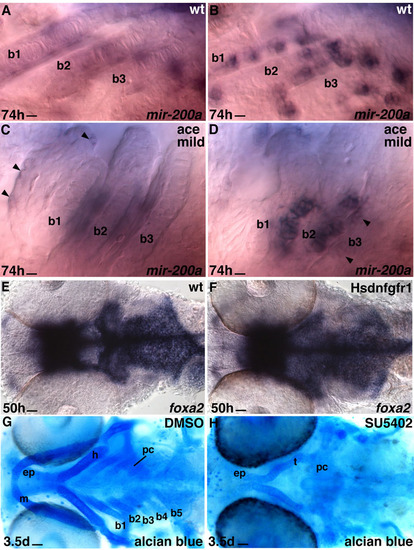Fig. S3
- ID
- ZDB-FIG-110804-20
- Publication
- Kapsimali et al., 2011 - Fgf signaling controls pharyngeal taste bud formation through miR-200 and Delta-Notch activity
- Other Figures
- All Figure Page
- Back to All Figure Page
|
Wild-type and mild ace-/- zebrafish hybridized with miR-200a probe. (A-D) High magnification of branchial arches 1-3 (b1-3) of wild-type (A,C) and mild ace-/- phenotype (B,D) hybridized with miR-200a probe. The photos are focused on the cartilaginous cells (C,D) and taste buds expressing miR-200a (A,B,D). The arrowheads (C,D) indicate weakly labelled taste bud cells. Despite the mild differences in ace-/- cartilage formation, the taste bud cell number is reduced compared with the wild-type sibling. Scale bars: 7 μm. (E-H) Compromised Fgfr signaling in the oropharyngeal cavity affects pharyngeal arch development but not early endoderm marker expression. DMSO/SU5402 in wild type or heatshock in tg(hsp70l:dnfgfr1-EGFP)pd1/+ embryos was applied at 40 hpf. Ventral views of whole-mount larval heads labelled with foxa2 probe (E,F) or stained with Alcian Blue (G,H). Most of the pharyngeal cartilage is absent in the SU5402-treated embryo (H) compared with the control (DMSO, G). Scale bars: 20 μm. b1-b5, branchial arches 1-5; ep, ethmoid plate; h, hyoid arch; m, mandibular arch; oe, olfactory epithelium; pc, parachordal; t, trabeculae. |

